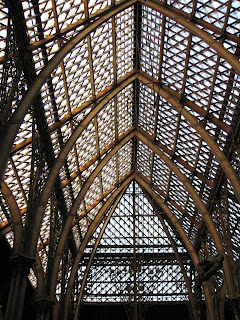I was lucky enough to be part of a 'behind the scenes' tour of Oxford University Museum of Natural History.
 The Museum is celebrating it's 150th anniversary this year. The building is Grade 1 listed and considered the finest example of Neo-Gothic architecture in Oxford.
The Museum is celebrating it's 150th anniversary this year. The building is Grade 1 listed and considered the finest example of Neo-Gothic architecture in Oxford. One of the aspects of the architecture that I had never considered is the lack of condensation in what is effectively a vast, metal framed, conservatory at the heart of the building. Apparently there is a built-in ventilation system that creates a continual flow of air throughout the building - amazingly far sighted for the period.
One of the aspects of the architecture that I had never considered is the lack of condensation in what is effectively a vast, metal framed, conservatory at the heart of the building. Apparently there is a built-in ventilation system that creates a continual flow of air throughout the building - amazingly far sighted for the period. Among its other architectural delights are the columns, nearly all of which are made from a different rock. The one shown left (from the upper Gallery) is of Porphyritic Granite from St Just in the far west of Cornwall.
Among its other architectural delights are the columns, nearly all of which are made from a different rock. The one shown left (from the upper Gallery) is of Porphyritic Granite from St Just in the far west of Cornwall. The Museum houses the University's scientific collections of zoological, entomological and geological specimens. As part of our tour we were taken into the Huxley Room with its recently restored ceiling and cabinets of entomological specimens. This is where, in 1860, the famous Huxley - Wilberforce debate on Charles Darwin's Origin of Species took place.
The Museum houses the University's scientific collections of zoological, entomological and geological specimens. As part of our tour we were taken into the Huxley Room with its recently restored ceiling and cabinets of entomological specimens. This is where, in 1860, the famous Huxley - Wilberforce debate on Charles Darwin's Origin of Species took place. Among its most famous specimens is a Dodo that still has some of its skin attached. This has been used for DNA testing that showed it to be a relative of the modern pigeon. As part of our tour we were also shown some of the museum's collection of Birds of Paradise. Sir David Attenborough will be giving a talk on these fabulous birds as part of the anniversary celebrations.
Among its most famous specimens is a Dodo that still has some of its skin attached. This has been used for DNA testing that showed it to be a relative of the modern pigeon. As part of our tour we were also shown some of the museum's collection of Birds of Paradise. Sir David Attenborough will be giving a talk on these fabulous birds as part of the anniversary celebrations. The museum is very popular with children as it displays a number of dinosaur skeletons. School visits are encouraged and trails are provided for other visits with extras activities scheduled for weekends and school holidays.
The museum is very popular with children as it displays a number of dinosaur skeletons. School visits are encouraged and trails are provided for other visits with extras activities scheduled for weekends and school holidays.Embedded in the grass in front of the building are casts of the footprints of the bipedal carnivorous dinosaur Megalosaurus from 168 million year-old limestones in Oxfordshire.
This is also a good spot from which to watch the swifts wheeling and screeching around the main tower, where they nest. When the birds return each spring cameras are activated to allow the public to view the nests.

No comments:
Post a Comment